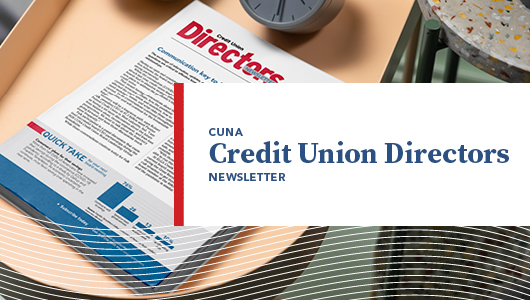
Gain momentum and propel the board forward
Examine your board’s practices to ensure it’s continuously moving ahead.
The credit union landscape has changed dramatically during the past year as the coronavirus (COVID-19) pandemic forced leaders to change how they operate and serve members.
Now, as more people are vaccinated and life begins to shift to the “new normal,” credit unions boards must look at how they operate moving forward.
“We have to acknowledge where we are right now. Everything has changed and we need to treat that as an opportunity rather than a point of panic,” says Kevin Smith, publisher and consultant at TEAM Resources. “How can we challenge our thinking, rethink, and capture momentum to propel us and credit unions into the future?”
During the CUNA Credit Union Board Accelerator Virtual Conference, Smith explored how boards can change how they think and operate to gain momentum and move forward in the future.
✔ Board thinking. The pandemic accelerated the rate at which leaders had to make decisions. Board members must challenge their thinking and determine how they might be holding the credit union back.
Consider these questions:
- How well do you know financials and ratios? If you need to slow down for repeated explanations, this can hinder the decision-making process. Be able to glance at the numbers, get the trend information, and be confident to see where red flags exist and ask further questions.
- How well do you know what’s taking place in the industry? Keep up with trade publications and read relevant material on a daily or weekly basis.
- Do you require relatively low spending approvals for the CEO? Allow the CEO to manage the budget and don’t require board approval for low spending amounts. While board members might believe keeping tight spending controls meets their fiduciary duty, “this is the kind of thinking that keeps you in the weeds,” Smith says.
Instead, establish a policy that sets limits. Spending decisions that fall outside those limits will require board approval, but the CEO will be able to act quickly on spending within the limitations. “Give the CEO the latitude to be nimble,” Smith says.
- Do you hold your colleagues accountable? Are all board members prepared for meetings? Do they prepare ahead of time and understand what’s going on? Talk to those who don’t and hold them accountable, Smith says.
“Accountability needs to be a high priority or you will not gain momentum,” Smith says. “Are you able to have difficult discussions? It’s about establishing a culture of accountability and talking about the minimum level of preparation and training.”
✔ Digital governance as flow. Board meetings are episodic, like a staircase, Smith says. Board members take steps, and when they reach a landing, there is a board meeting. Progress can be slow.
Instead, Smith advises board members to think of a circular staircase, where they can get information, ask questions, get a response, and turn it into new information between board meetings. Acting between meetings can allow your board to gain momentum and move forward.
“Using the right tools and the right thinking will allow you to get out of the episodic mindset and into the mindset of governance as flow,” Smith says. “This about your mindset and your philosophical approach to governance.”
✔ Board composition. Does your board have a succession plan that addresses how to fill vacant board seats with people who have the right skills and knowledge, but also represent the credit union’s membership? If not, come up with a plan.
“Figure out what you have and what you would like to have. Then, identify the right gaps and find the right people,” Smith says. “It’s impossible to get it perfect, but we can always lean toward a better version or as close to perfect as we can get.”
This article initially appeared in Credit Union Directors Newsletter, which provides strategic insights for policymakers. Subscribe now to the print or PDF version.
